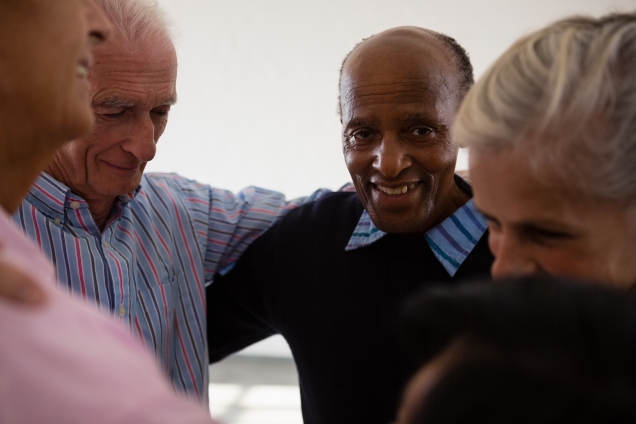Am I Experiencing Vicarious Trauma?
- Category: Living Well, Trauma Center
- Posted On:
Authors: Jennifer Hughes, Ph.D., and Alisha Bowker, LCSW, University Medical Center Trauma Recovery Clinic Team
At times it can feel nearly impossible to find the motivation to keep showing up to work, week after week, especially after working long hours or dealing with crises and looming deadlines. Working in the medical and helping fields, especially, we are often overwhelmed with horrific stories of violence, pain, and trauma, which can dramatically alter the way in which we understand the world, ourselves, and others.
The clinical term for this phenomenon is Vicarious Trauma (VT).

What is Vicarious Trauma (VT)?
Vicarious Trauma can be defined as a change in a helper’s inner experiences after working with people who have experienced traumatic events. Trauma can be defined as a deeply or distressing event that one directly witnesses or hears about. This can include natural disasters, interpersonal violence, war, divorce, childhood abuse, and so on.

Does Everyone Experience VT?
VT is a natural consequence of being an empathetic human, and being exposed to a population that has experienced trauma. Those often impacted by VT are social workers, case managers, doctors, nurses, first responders, etc. It is an inevitable hazard in these lines of work and, unfortunately, cannot be avoided, but definitely can be addressed and managed.
VT can also extend not only to helping professionals who work with this population but also to the caregivers or loved ones of a survivor.

How Does VT Impact My Life?
Vicarious Trauma is an ongoing process that slowly builds over time the longer we are exposed to the stories of trauma survivors. It generally begins to impact us in three different realms:
- Identity: It begins to impact our identity, which changes the way we see and define ourselves.
- Worldview: It impacts our worldview by skewing the ways in which we understand others or understand how to interact with those around us.
- Spirituality: It can impact our spirituality, and replace feelings of hope with feelings of cynicism and despair.

VT Versus Burnout
Vicarious Trauma is different than burnout, as it truly only develops after being exposed to traumatic stories. Burnout is a state of chronic stress, particularly in a work environment, that leads to physical and emotional exhaustion, cynicism, detachment, and feelings of worthlessness.
While the symptoms are similar, burnout is generally not rooted in trauma exposure.
Signs and Symptoms of VT
Some of the most common signs and symptoms of VT fall under these 5 areas:
- Cognitive: Intrusive thoughts, sounds, or images about the traumas an individual has been exposed to, difficulty concentrating, constantly thinking about survivors outside of work, becoming more cynical or negative in one’s thinking patterns.
- Physiological: Ulcers, headaches, chronic pain, stomach aches, sweating, or heart racing when reminded of a trauma
- Spiritual: Lose hope, see others as bad or evil and lose sight of the good in humanity, difficulty trusting our own beliefs
- Behavioral: Hair trigger temper, isolating, using unhelpful coping to manage big feelings (drinking, drugging, gambling), need to control everything and everyone
- Emotional: Lose touch with one’s own self-worth, isolate from loved ones, feel overwhelmed or emotionally restricted

So now that we have the language to define the symptoms we are experiencing, what can we do about it?
Thankfully there is an answer for this and it can be broken down into three phases:
Anticipate and Protect, Address and Transform
- Anticipate and Protect: Arrange things ahead of time to anticipate the stress of your work and its impact on you.
- Become aware of VT and start to look out for signs and symptoms. Intentionally plan for a healthy balance between your work life and personal life.
- Find a support system, particularly amongst colleagues who share this language and can support you as needed.
- Address: How you take care of yourself in and out of work
- Engage in Self-care: Attending to yourself physically, spiritually, emotionally, and psychologically
- Self-nurture: Engaging in activities or things that provide comfort, relaxation, and play
- Escape: Getting away (whether literally or mentally)
- Transform: Transform the negative aspects of this work into positive connection and meaning
- Create Meaning: Find ways to hold onto your values and identify even in the face of trauma
- Infuse current activities with new meaning: Mindfulness, Connection to others
- Challenge negative beliefs: Actively challenge negative thoughts or cynicism/ Re-frame your thinking
While vicarious trauma is a very common and inevitable consequence of the work that we do, the exciting news is that we have the tools to fight back. This is an ongoing process that will continue to look different at different stages of our careers, so it is a process we must continuously be engaging with.
Both individually and collaboratively, begin to identify the signs of VT in your own life and use the template above to make a plan for how to begin addressing and counteracting these symptoms.

Remember, you are not alone with your vicarious trauma, and do not have to manage it alone either.


